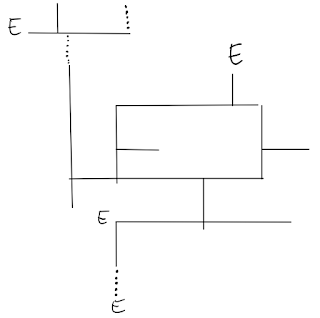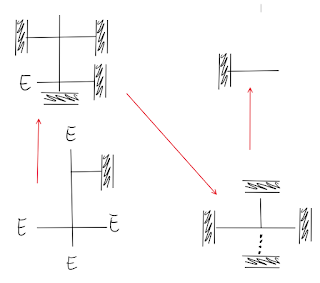Since I last looked at TotSK's mapping (two weeks ago?! Time flies) I've gotten some extra practice at mapping and finally got cracking on Castle Xyntillan. Since Melan himself said that he hasn't made such a diagram for the dungeon, this should be taken with a bucket of salt, and the knowledge that this is not an analysis by an experienced game designer (of the sort Melan just did for Winter Tombs) but an exercise by a novice designer to dissect a complex piece and try to figure out how it works.
To start off, I'm looking at the six above-ground sections of the castle, since these are smaller and each is mostly self contained, unlike the sprawling dungeon and main floor levels which I dread trying to map.
I use the same tracing, sketching and finalizing process I used in my post about TotSK, but for brevity (and in order to not show any of the maps directly) I'll only be showing the final diagrams, with some annotation when I want to point out specific features.
Es represent entrances from another level, which might be horizontal or vertical, while parallel lines with squiggles represent stairways within a single section. Dotted lines represent secret or blocked doors and passages.
The Upper Floors
Section C, 'The Gothic Wing I' is located near the entrance to the castle, and is likely the first of the upper levels the party will visit. Its level of difficulty is close to that of the lower floor that it connects to, but it contains a good deal of treasure. It boasts a fair number of entrances, though variously hidden in amusing places or guarded by an encounter too deadly for a 1st level party to deal with in a head-on fight.
It's also quite well looped; there are four overlapping loops in the main body of the floor. The placement of the encounters in the upper part of the diagram makes it very likely the party will run into a couple of treasure heavy rooms. While it's not combat heavy, the floor also introduces some tougher enemies the party will be seeing more elsewhere, but makes fighting them optional or isolates them from the body of the floor, in a location that makes it relatively easy to escape to another floor or to the outside of the dungeon.
And don't forget that this section hides an entire hidden subsection. It's just a few rooms, but it prepares the party for later areas. The presence of this hidden region can be discovered quickly if the party is mapping carefully, as mine is, and its presence becomes very obvious once the party reaches section D. Though my party has determined its rough location, they have yet to find a way in.
Section D, 'The Gothic Wing II' can only be accessed by the first floor of the Wing, and doubles down on the previous floor's lessons. Like the previous floor, it's not very combat focused, with the greatest challenges coming from tricks, traps and interactivity. If the party has been mapping carefully, some secrets in this wing will become quite obvious.
This wing is likely to be the first exposure the party has to a demiplane which runs through the castle. Also, it provides the conclusion to The Toilet Gag. I provide no explanation for either feature, and hope the burning desire to know the answer will encourage you to purchase the adventure yourself.
Section F, 'The Upper Quarters' is built similarly to the Gothic Wing, de-emphasizing straight out combat encounters in favor of traps and interactive dangers. It even boasts a hidden area, which for those on a certain geas-quest will be quite important.
In terms of mapping, it's positively riddled with entrances, many hidden, but is considerably less loopy than the Gothic Wings, and the likely combat encounters aren't immediately accessible from the section's hub. A careless mapper might place multiple loops due to the presence of many small, interconnected rooms adjoining a larger one, but I cleaned those out of the model.
Out of the entire castle, section G, 'The Donjon' is the most linear. However, it's characterized by a large number of entrances between a very small number of actual rooms, may of them unusual. It does hide one nasty, but potentially very profitable secret, and leaves the method of obtaining it implicit, for players and GM alike to discover by exploring the map. Also, the vertical progression has an absurd cap when the party discovers the way to the top.
Section I, 'The Lake Tower' isn't quite as sparse as G, but neither is it as varied in its entrances and exits. There's just the one entrance, and the upper levels provide an almost predetermined path, unless you find one of a few secret doors, which mostly allow you to skip a room and find an extra hidden area, like in C.
This is an example of a tight loop composed of only a few rooms, which would show up as a larger, multi-part loop if you stuck to the regular mapping method without cleaning it up. This is one of the limitations of the diagram, that the scope insensitivity indicates the existence of loops where they are actually trivial.
Section L, 'The Maze of the Occult' is arguably the most dangerous of all the castle's sections. This is, however, quite adequately signposted. Most of the entrances, obvious, secret and vertical, link to very dangerous rooms on the lower floors. It's very unlikely, though still possible, to reach section L without too much difficulty if one follows a very particular path and gets a bit lucky, but this would result in a very nasty difficulty spike for said party.
Here in the L section we see a good deal of looping and complexity. However, not all of the section is obviously accessible from multiple angles. The lower part of the diagram is only obviously accessible through the chokepoint at L6, which just so happens to be a very nasty trap. There are ways to bypass it via secret blocked off doors, but one is extremely dangerous and the other is so well hidden I doubt any party would find it from the useful end. It so happens that the rooms hidden behind this chokepoint are some of the deadliest in the entire castle, in addition to containing a portal to a certain demiplane.
Some more neat features: on the upper left, three rooms must be discovered sequentially, and likely experienced in the same way. These rooms happen to be very theatrical and showy, with a great deal of interactivity. Though it is technically possible to enter this section via the entrance in the top left corner, it's blocked by some nasty traps, and in practice the party is extremely likely to find the secret entrance to the right before it becomes passable, providing an additional environmental gate and puzzle.
Takeaways
Are there any particular patterns we can glean from this? At a moment's glace, I see frequent use of gatekeeping mechanisms, hiding clusters of tough encounters (and the appropriate treasure) behind deadly rooms that test if the party is ready to enter the area or not.
In the earlier, easier areas, straight combat and highly lethal traps are de-emphasized in favor of interactivity, and where tough combats do exits they are usually placed at the end of short chains of rooms, and not far from an exit.
Where heavy NPC or environmental interaction is present, room progression is often much more linear, though I can't say for sure this is a pattern rather than my spurious assumption.
A few shapes keep cropping up. Boxes with sticks inside of them, overlapping boxes or boxes entirely contained in other boxes. I can only assume that there features would be even more prevalent in the dungeon and main floor sections.
The diagrams also show that areas like the Lake Tower, despite being composed of several adjacent rooms, don't loop horizontally very much, but are heavily jaquaysed vertically, which this sort of diagram doesn't show very well. If nothing else, I'm now more familiar with the strengths and weaknesses of this method.
Until next time, be sure to subscribe to the blog to see every post when it comes up, and let me know what you think in the comments below!






Hmmm intriguing! Maybe having a basic vertical map along with the horizontal might help to visualise the vertical jaquayment? It's interesting how loops prevent the possibility of a linear (read: pre-planned) adventure, which will probably help with writing style as well.
ReplyDeleteWhen I hear 'vertical map' I think of the abstracted floor plans of old school dungeons, showing the themes levels and the passages between them. Doing such a thing for Xyntillan is beyond my measly brain, and might require 3-D rendering software.
DeleteYou can draw a continuous spectrum between maximum linearity and minimal linearity by looking at the number of possible paths (more accurately, possible orders of experience). If your dungeon is a straight line, you know the order in which everything will be experienced. If your dungeon is a grid the party starts in the middle of, with the same level of difficulty in any given direction, you have minimal ability to predict. Xyntillan's gatekeeping methods make it very likely you will have experienced certain encounters or locations first, if just to avoid getting in over your head.